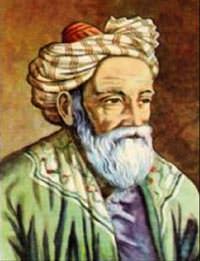
Omer Hayyam was a poet, mathematician, philosopher and astronomer who lived in Persia.
Omar Khayyam was famous during his times as a mathematician. He wrote the influential Treatise on Demonstration of Problems of Algebra (1070), which laid down the principles of algebra, part of the body of Arabic Mathematics that was eventually transmitted to Europe.
Like most mathematicians of the period, Omar Khayyám was also famous as an astronomer. In 1073, the Seljuk dynasty Sultan Sultan Jalal al-Din Malekshah Saljuqi (Malik-Shah I, 1072-92), invited Khayyám to build an observatory, along with various other distinguished scientists. Eventually, Khayyám and his colleagues measured the length of the solar year as 365.24219858156 days (correct to six decimal places). This calendric measurement has only an 1 hour error every 5,500 years, whereas the Gregorian Calendar, adopted in Europe four centuries later, has a 1 day error in every 3,330 years, but is easier to calculate. He demonstrated that earth revolves on its axis, bringing into view different constellations throughout the night and day (completing a one-day cycle). He also elaborated that stars are stationary objects in space which if moving around earth would have been burnt to cinders due to their large mass. Some of these ideas may have been transmitted into the Christian science post Renaissance.




Leave a Reply
You must be logged in to post a comment.